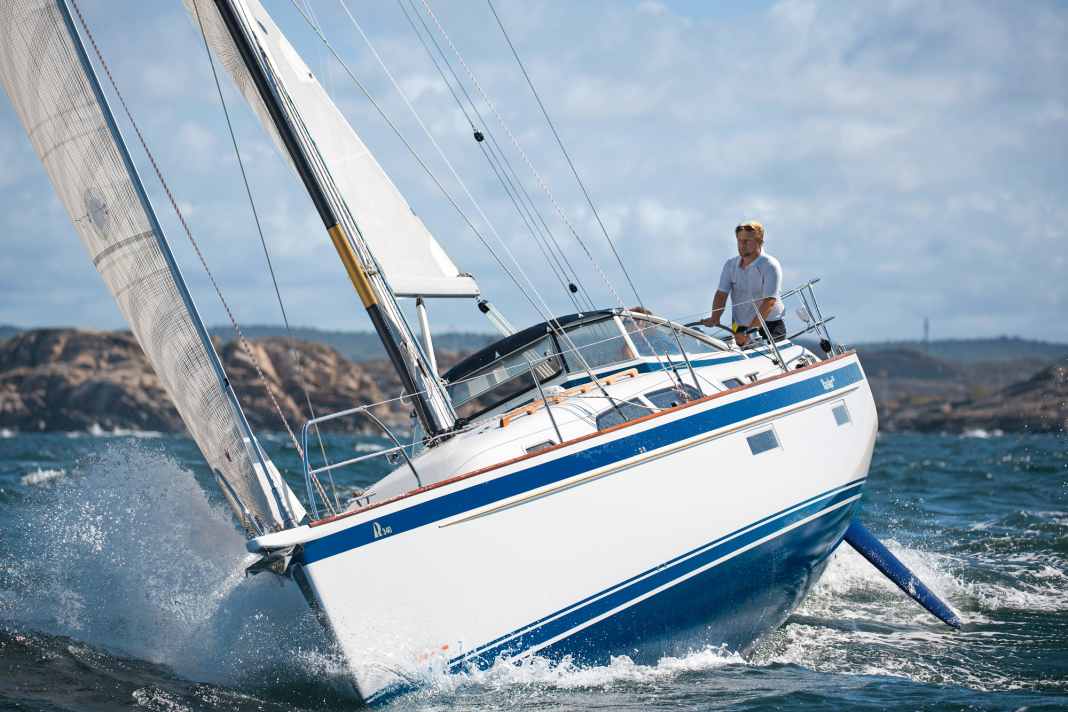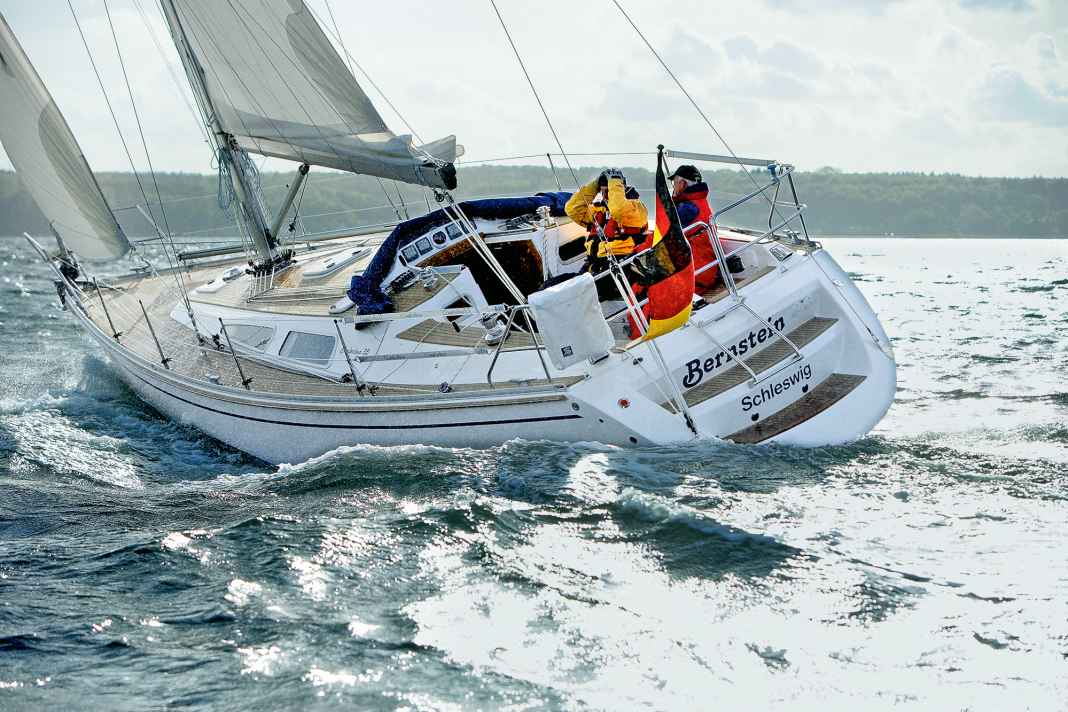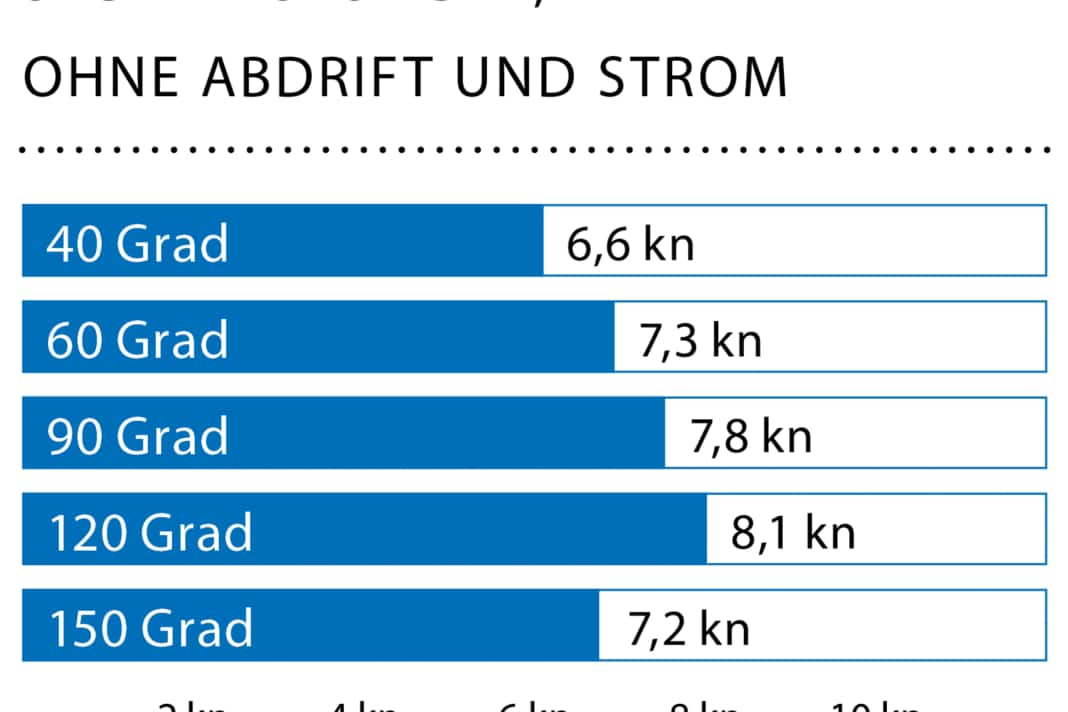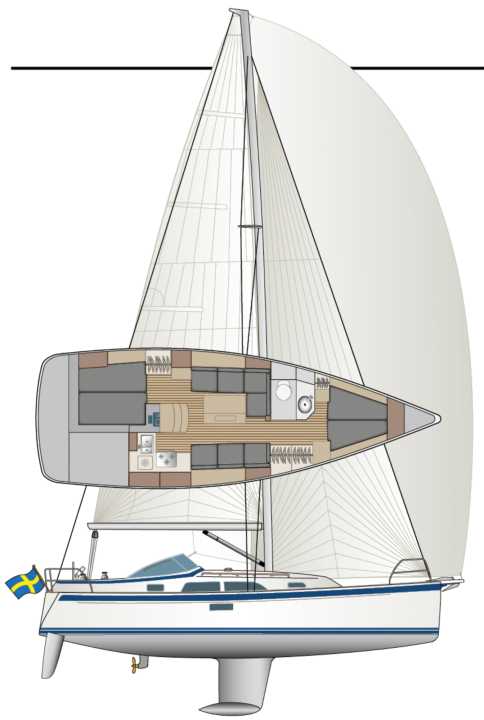Hallberg-Rassy 340 on test: Agile and good-natured sailor - the ideal cruising yacht?






Shortly before the Öppet Varv boat show, the Hallberg-Rassy harbour in Ellös is packed with yachts. Most of the boats measure 40 feet and over. Four of the top model HR 64 alone are moored in the basin. Between them, directly under the mast crane, the freshly rigged 340 is waiting for the test crew. Construction number 1 is barely in the water for more than an hour.
Dark blue trim strips, a clear deck moulding, a teak-covered bulwark, a fixed windscreen and a solid rubbing strake: The classic HR attributes are there, but with an impressive 1.34 metres freeboard height at the bow and still 1.15 metres at the stern, the hull is quite dominant. And you can also see from the superstructure that there is plenty of headroom below deck.
Compared to the predecessor model HR 342, which was built for 13 years, the hull lines with a vertical stem and wide stern appear almost radical. One would not have expected such a leap in design from a traditional company with a reputation for building solid, but also conservative cruising yachts.
The competition






Of course, shipyard boss Magnus Rassy had already tested the boat before the company holidays - but then it went straight back into the hall. As a result, the Rassy has not yet clocked up 50 miles in the wake, let alone had a crew on board overnight. This is exactly what the programme for the next two days envisages. Instead of a short cruise, the YACHT top test includes an extensive cruise - including overnight stay, breakfast and dinner.
This much in advance: we would hardly have slept better in a hotel. The light, air, berth dimensions, mattress quality and freedom of movement in the fore and aft compartments are just as impressive as the privacy offered. Only the charger installed in the forward locker detracted from the night's sleep, as it generated a lot of waste heat despite the full batteries and its fan ran almost continuously. A point that the shipyard should simply get to grips with.
But back to the beginning: the most striking innovation is the almost triangular hull shape. The maximum width of 3.47 metres is around two thirds of the ship's length and decreases by just 20 centimetres towards the stern.
The additional buoyancy in the stern also requires more volume in the foredeck so that the boat does not trim in the wind. Both together increase the amount of space on and below deck enormously. The cockpit is not only much wider, but also 42 centimetres longer than on the previous model. The waterline has grown by more than a metre. In this size of boat, that's a world of difference.
Double & good
The protruding shape has consequences for the steering system. A central fin would have to be positioned very far forward or go very low so as not to be lifted out of the water when the boat is in position - neither of which are ideal solutions. Instead, in-house designer Germán Frers has opted for a twin rudder system with comparatively small blades positioned very far aft. They are steered by a tiller as standard. However, the test boat is equipped with two steering wheels - an option that costs a hefty surcharge.
The success of the rudder system becomes apparent as soon as you cast off. Due to the system, manoeuvres from a standstill are more difficult as the off-centre blades are not in the propeller beam. Nevertheless, the HR turns very agilely even at the slightest forward motion and turns in about one ship's length. Harbour manoeuvres are therefore no problem. The optional retractable bow thruster is recommended for strong crosswinds. The power unit comes from Sidepower and is very powerful, but also costs extra.
The costs are relativised if the electric headsail furling system or the electric anchor winch are ordered at the same time, as batteries and charging technology are only required once. The test boat is equipped with all these extras, so hoisting the sails is correspondingly easy. While the main is hoisted by hand, unfurling the genoa is limited to the push of a button. The advantage of the direct electric drive is that there is no need for the cumbersome reefing line and its guide into the cockpit. Electric halyard and sheet winches are also available, but are not absolutely necessary, as the concealed halyard guide works with pleasantly low friction and the crank position is good. However, the fact that an extra 300 euros is charged for self-tailing halyard winches does not match the basic price or the concept.
Under sail, the positive impression of the rudder tuning is even stronger. Even in winds of only 8 to 10 knots, the Rassy picks up speed quickly and feels lively - no trace of the inertia that is sometimes typical of twin rudder systems, no sign of a spongy steering feel. The system does not provide much pressure, but the feedback is so direct that you can sail cleanly and relaxed on the wind edge. With a turning angle of just 80 degrees, a good 5.5 knots are possible.
The Swede's agile response is evident when tacking. Until you get used to the unexpected ease of turning, the course changes can be so abrupt that the boat sails on a half-wind course on the new bow. All the more astonishing, then, is the boat's directional stability when the wind picks up and the gusts come in. Thanks to the enormous beam and deep keel, the Rassy sails very stiffly, and even stronger heeling has almost no influence on the trim thanks to the double rudder system; the rudder pressure hardly increases noticeably, and it is not necessary to ease the mainsheet or the already very short traveller in pushers.
Rough instead of dull
On the second test day, the wind picks up to 15 to 18 knots and turns to the south-west. This means that there is an unpleasantly steep wave of around 1.5 metres in front of the archipelago. Even in these adverse conditions, the 34's relaxed yet sporty character is surprising.
Despite the plump foreship, the hull settles smoothly and hardly loses any speed. The twin rudders prove to be a real blessing; there is never any fear of stalling. However, active steering is required to find the optimum course over the water, as the boat's ability to turn requires quick corrections. The tiller version is likely to have an advantage in such conditions.
A sheltered cockpit is one of the classic Hallberg-Rassy virtues, so it's not surprising that we don't get a drop, even though the bow occasionally disappears into a wave crest and the water rushes over the side deck like a mountain stream downwind. What is particularly pleasant is that the protection does not obstruct the view. Even when seated, the helmsman has a clear view forwards and into the sails.
However, there is a lack of support for the feet when heeling heavily. The position of the centre-mounted backstay is also not quite ideal; it hinders the change between the steering wheels and restricts the central passage to the optional bathing platform. The 1.5 square metre fold-out sea terrace costs extra; the stern is open as standard.
Cosy as usual
Externally, the Hallberg-Rassy may belong to a new generation, but below deck the solid real wood ambience in the best Scandinavian boatbuilding tradition still prevails. Of course, time has not stood still there either. The lines are clear and unadorned, and the woodwork and paintwork are of the highest quality, even in places that are difficult to see.
The large, flush-mounted side windows made of toughened glass, together with the flush-mounted deck hatches and the hull windows in the saloon and aft cabin, provide a beautiful view and plenty of natural light. In addition, direct and indirect LED lighting is already included as standard and can be extended on request.
In order to make optimum use of the space available on the hull lines, shipyard boss Magnus Rassy has chosen a layout that is rare for this size of boat. As with its little sister, the HR 310, the washroom is at the front. This moves the saloon aft and significantly increases its volume. In keeping with this, the L-shaped galley is also mounted more or less backwards, with its short side positioned at the companionway bulkhead. This means that the cook can wedge himself between the stairs and the cooker at sea, and the paths between the companionway and the saloon and into the aft cabin remain clear when cooking.
Also familiar from the HR 310: The navigation table has been done away with, and in its place the Swedes have simply installed a control cabinet with a shelf about the size of an A3 - an acceptable compromise in view of the two plotters and the two large shelves behind the fixed windscreen in the cockpit. The space freed up benefits the seating areas in the saloon, which are two metres long and 91 centimetres wide, making them comfortable single berths.
As mentioned at the beginning, the fore and aft compartments are also equipped with comfortable berths. In the stern, the length is a little shorter, but no parts of the rudder mechanism protrude into the footwell, and the headroom above the berth is very comfortable.
A clever door solution catches the eye on the way to the foredeck. Most 34s are likely to be manoeuvred by crews of two, so the passageway to the bow compartment remains open. If more privacy is required, the owner's area can be separated. An oversized cupboard door closes either the clothes storage space or the path to the berth - and in such a way that the wet room can still be used by guests.
The range of easily accessible lockers, cupboards and stowage spaces is typical of Rassy. Luggage for longer trips can easily be stored in the foredeck in particular, but there is also no shortage of space in the galley, forecastle lockers and the two-storey anchor locker. Even 40 metres of anchor chain look almost lost under the intermediate floor of the bow storage space.
Inevitably expensive
As expected, the HR 340 is no bargain. However, for just over 300,000 euros, you get a very solid and well thought-out yacht in which every detail conveys tangible quality. The basic equipment is also very comprehensive. And then there is something else that impresses: the modern hull lines and the twin rudder system enable sailing characteristics that were recently reserved for performance cruisers. At the same time, the boat sails as good-naturedly and comfortably as you would expect from a good cruising yacht.
The measured values for the Hallberg-Rassy 340 test






The Hallberg-Rassy 340 in detail

Technical data of the Hallberg-Rassy 340
- Designer: Germán Frers
- CE design category: A
- Torso length: 10,36 m
- Total length: 10,95 m
- Waterline length: 10,10 m
- Width: 3,47 m
- Draught/alternative: 1,90/1,55 m
- Theoretical torso speed: 7.72 kn
- Weight: 6,0 t
- Ballast/proportion: 2,3 t/39 %
- Mast height above waterline: 16,46 m
- Mainsail: 33,9 m2
- Furling genoa (109 %): 32,0 m2
- Machine (Volvo): 21 kW/29 hp
- Fuel tank: 188 l
- Fresh water tank: 277 l
- Holding tank: 85 l
Hull and deck construction
GRP sandwich construction with foam core. Built using the hand lay-up method with vinylester and polyester. Main bulkheads laminated to the fuselage
Equipment, price and shipyard
- Base price ex shipyard: 308,925 € gross incl. VAT.
- Standard equipment included: Sail, engine, sheets, railing, navigation lights, battery, compass, cushions, galley/cooker, bilge pump, toilet, sailcloth, fenders, mooring lines, fire extinguisher, electric cooler, holding tank with suction, antifouling
- Also included in the price: Fixed windscreen, rubbing strake, bowsprit, furling system below deck
- Guarantee/against osmosis: 1/1 year
As of 05/2024, how the prices shown are defined can be found here!
Shipyard
Hallberg-Rassy Varvs AB, 47431 Ellös; www.hallberg-rassy.com
Distribution
Hallberg-Rassy Deutschland GmbH, Horst von Hörsten, 23730 Neustadt, Tel. 04561/55 86 48, www.hallberg-rassy.com
YACHT review of the Hallberg-Rassy 340
The HR 340 continues the generation change that began with the 44. The combination of agile and at the same time good-natured sailing characteristics is very successful and makes it the ideal cruising yacht
Design and concept
- + Modern hull lines
- + Robust construction
- + Very good double rudder system
Sailing performance and trim
- + Very lively, yet always reliable
- + Sailing performance very easy to retrieve
- + Neutral, but good steering feel
Living and finishing quality
- + Very good space
- + High-quality and solid fit-out
- + Seaworthy equipment
Equipment and technology
- + Very high-quality components
- + Exemplary installation
- - Charger installed unfavourably
The Hallberg-Rassy 340 in video
The article first appeared in YACHT 20/2017 and has been updated for the online version.

